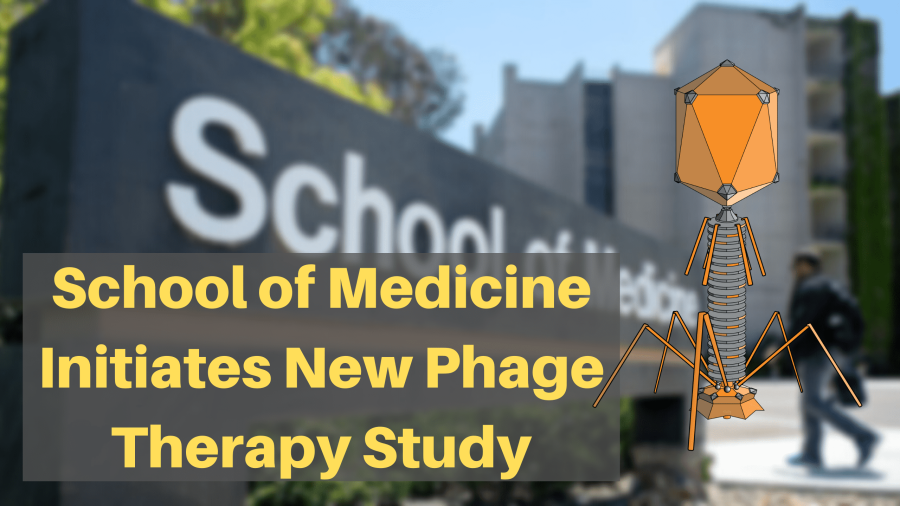In a recent UC San Diego School of Medicine study, successful mice trials for a new treatment show promising results on the use of phage therapy to target alcoholic liver disease. The researchers have been conducting such trials since Spring 2017.
Bacteriophages, or phages, are naturally present viruses that infect and “eat” bacteria. Unlike antibiotics, which also destroy bacteria in a “kill-them-all” manner, phages target a particular kind of bacteria strain with minimal side effects. Since phages live on bacteria, the phage degrades when the host bacteria dies. Due to the high specificity of the target bacteria, phage therapy is still a limited application in practice, which makes it a field of massive study for researchers.
At present, the most commonly used treatments for alcoholic liver disease include liver transplantation and corticosteroids, a hormone used to reduce liver inflammation. However, liver transplantation is not a readily available option as the national waitlist for a healthy liver is approximately 14,000 people long, and surgeries are offered at a select few medical centers. Likewise, corticosteroid treatment is not a guaranteed solution as the effects of the treatment vary among different individuals.
Liver damage accumulates over years of alcoholism. Once severe symptoms begin to show, up to 90 percent of patients die within 90 days of a diagnosis of severe alcoholic liver disease, known as alcoholic hepatitis.
With a focus on the relationship between liver disease and intestinal microorganisms, the Dr. Bernd Schnabl Lab at UCSD has identified and correlated bacterial infection with liver disease in their previous study.
Yi Duan, a postdoctoral student in Schnabl’s lab group and the first author of the research paper, spoke to the UCSD Guardian about the correlation between liver damage and phage treatment.
“Alcohol can directly damage liver cells, therefore typically the liver injury in those patients was considered to be caused mainly by alcohol, not by bacteria infections,” Duan said. “Because of this, phage treatment was not considered as a treatment for alcoholic liver disease before.”
In both the human case studies and the mice experiments, the group found that the translocation of the gut bacteria, Enterococcus Faecalis, can cause bacterial infection in the liver. Additionally, proton-pump inhibitors or PPIs, a commonly used drug to reduce gastric acid secretion and acid reflux for patients with chronic liver disease due to alcoholism, create a positive feedback loop in patients which worsens the condition.
Postdoctoral student and co-author of the paper Cristina Llorente elaborated on the side effects of PPIs to the Guardian.
“[PPIs cause] expansion of Enterococcus Faecalis, and ethanol increases intestinal permeability, and then Enterococcus Faecalis [that] translocates via portal vein arrives to the liver,” Llorente said.
The group’s previous study on the translocation of Enterococcus faecalis was published in October 2017, and the result provided motivation for the current project of phage therapy.
The researchers isolated four different phages from sewage water that target Enterococcus faecalis. They found that some Enterococcus faecalis can secrete a toxin called cytolysin. In the mice trials, the team and collaborators transferred feces from people with alcoholic disease to the mice. The results showed that while not all Enterococcus faecalis are cytolysin-positive, there is a positive correlation between cytolysin-positive Enterococcus faecalis and the severity of the disease. Likewise, the presence of phage decreased cytolysin and alleviated alcoholic liver disease in the group of mice overall.
Now that the researchers have found that phage therapy leads to an on-average positive result in humanized mice groups with alcoholic liver disease, the next step for Schnabl’s lab is to test the safety of phage therapy in humans to validate their findings in clinical trials. This research is a part of a long-term effort among multiple institutions over the past years, and continuous progress is made to move beyond simply identifying the problem.
List of co-authors of the research paper:
Yi Duan, Cristina Llorente, Lu Jiang, Samuel B. Ho, UC San Diego and Veterans Affairs San Diego Healthcare System; Sonja Lang, Katharina Brandl, Huikuan Chu, Jinyuan Liu, Yukiko Miyamoto, Melissa Ly, Bei Gao, Weizhong Sun, Roman Kiesel, Felix Hutmacher, Suhan Lee, Xin M. Tu, Lars Eckmann, UC San Diego; Richard C. White, Thomas H. Clarke, Kevin Nguyen, Manolito Torralba, Derrick E. Fouts, J. Craig Venter Institute; Yan Shao, Trevor D. Lawley, Wellcome Sanger Institute; Adriana Hernandez-Morales, Lauren Lessor, Texas A&M University; Imran R. Rahman, University of Illinois at Urbana-Champaign; Meritxell Ventura-Cots, Ramon Bataller, University of Pittsburgh Medical Center, Pittsburgh Liver Research Center; Francisco Bosques-Padilla, Universidad Autónoma de Nuevo León; Elizabeth C. Verna, Columbia University; Juan G. Abraldes, University of Alberta; Robert S. Brown Jr, Will Cornell Medical College; Victor Vargas, Universitat Autònoma de Barcelona and Centro de Investigación en Red de Enfermedades Hepáticas y Digestivas; Jose Altamirano, Universitat Autònoma de Barcelona; Juan Caballería, Centro de Investigación en Red de Enfermedades Hepáticas y Digestivas and Liver Unit, Hospital Clinic, Barcelona; Debbie L. Shawcross, King’s College London; Alexandre Louvet, Philippe Mathurin, Hôpital Huriez; Michael R. Lucey, University of Wisconsin; Guadalupe Garcia-Tsao, Yale University and VA-CT Healthcare System; Wilfred A. van der Donk, University of Illinois at Urbana-Champaign and Howard Hughes Medical Institute; and Peter Stärkel, St. Luc University Hospital, Université Catholique de Louvain.














